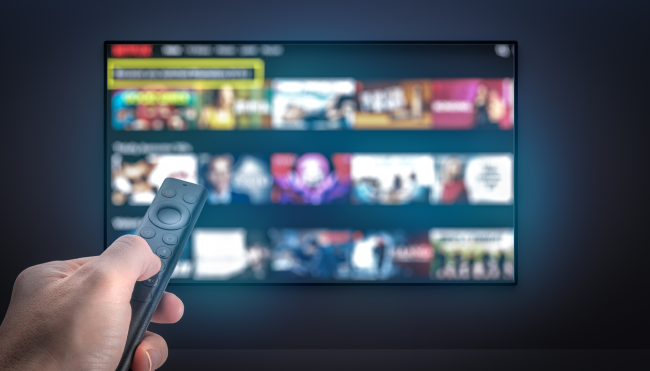- Why Amagi
-
Solutions
Contact UsBusinessWho We Serve
- Offerings
- AI
-
Resources
Contact UsINDUSTRY REPORTSAmagi FAST Report #15: The Power of Live Programming: A Catalyst for Streaming SuccessAugust 21, 2025Read More
-
Company
Contact UsNewsroomAmagi launches AI-powered Smart Scheduler to improve content programmingApril 3, 2025Read More
Blog
How emerging FAST services can set themselves apart from the competition
By Yogita Khinchi - May 14, 2025
The Free Ad-Supported Streaming TV (FAST) market is expanding rapidly. As more players enter the space, competition intensifies, encouraging new entrants to be more strategic and innovative in establishing themselves. While early adopters and pioneers are reaping the benefits, those entering the market now, though, have an option to leverage the approaches of pioneers — also need to explore additional strategies for success.
We'll break down potential paths forward for emerging FAST entrants in terms of monetization and how they can adapt to changing viewership and ad consumption trends.
How can FAST services differentiate themselves?
Based on the data and insights from certain FAST channels distributed using Amagi THUNDERSTORM, our SSAI (Server-Side Ad Insertion) platform, the global hours of viewing (HOV) and ad impressions show a Year-over-Year growth. Additionally, newcomers in the FAST ecosystem are eager to capitalize on this trend.
With a number of FAST services now available, the key question for new entrants is: How can we differentiate our service? Viewers tend to seek unique experiences, and merely replicating existing strategies for monetization and viewership expansion may not be enough.
Some of the primary challenges newcomers may face include:
- User acquisition and retention: How can platforms attract viewers and ensure they remain engaged over time?
- Monetization: How can content be effectively monetized with ads that reach the right audience at the right time and on the right device?
- Real-time insights: How can platforms track Return on Investment (ROI) in real-time to optimize strategies?
While it is implied that technology is the driving factor for established FAST players to switch gears towards potential profitability, improving viewer experience is their differentiator. On the other hand, for new entrants, building from the ground up and investing in technology that provides seamless user engagement, precise analytics, and optimized ad placements are critical.
How are video services adapting to changing audience preferences?
The video streaming landscape is undergoing a transformation, with traditional models converging with FAST:
- Pay TV services now offer FAST channels
- SVOD services are introducing ad-supported tiers and linear channels
- FAST services are integrating AVOD and linear content more seamlessly
Existing VOD and FAST players are adapting quickly to evolving audience preferences, ensuring they remain competitive in this crowded market.
READ: How FAST channels complement on-demand strategy
Accelerating success through efficient monetization strategies
1. A holistic approach to FAST
Viewing FAST as a simple replication of cable TV on CTVs is a narrow perspective that fails to leverage the full power of the internet. Viewers expect more than just linear content—they also prefer watching on-demand programming and live events.
FAST providers should diversify their offerings by incorporating both on-demand and live content, creating more opportunities for ad monetization. This hybrid approach boosts engagement and extends viewing time, as seen with platforms like Pluto TV, which provides a mix of live and on-demand content across multiple genres.
2. Tap into new formats and advertiser demand
.png?width=764&height=435&name=L-Band_1%20(1).png)
The FAST model tends to rely on advertisement-based revenue; however, excessive or repetitive ads can drive viewers away. New channels must look to adopt hyper-personalization and contextual advertising while balancing in-stream (pre-, mid-, and post-roll video ads) and in-content ad placements.
- In-Content ads blend seamlessly with content while being impactful. These non-linear ads provide an effective way to engage audiences, especially during live events, such as sports broadcasts and news, without interrupting the viewing experience. In-content ad formats offer incremental opportunities to reach audiences in newer ways without increasing the ad pod length.
- Ad slates negatively impact viewer retention. Amagi ANALYTICS, our viewership and ad analytics platform, shows a drop in viewership when slates appear. Amagi's Zero slate solution adjusts ad breaks, reducing the need for slates and improving the overall viewing experience.
- Programmatic Advertising automates ad inventory management. Amagi THUNDERSTORM supports features like error beaconing, ad tiering, and frequency capping to enhance ad delivery and monetization.
READ: FAST monetization strategies to drive revenue
3. Leverage data to optimize content and Ad delivery
Data-driven insights play a critical role in audience engagement and ad performance optimization.
- Personalized content and ads: Imagine switching on a FAST channel and seeing a lineup of shows you love watching — this saves you from the paradox of choice and time required for content discovery.
- Ad optimization: Capabilities like Amagi THUNDERSTORM's Pod Optimization suite help you optimize ad delivery to maximize fill rates.
-
- Pod-split: This feature breaks a long ad pod into smaller sub-pods, with each sub-pod's ad request processed sequentially, improving render rates.
- Mid-break join: This innovative feature enables ads to be served to new audiences joining during ad breaks, effectively boosting impressions.
- Efficient ad tiering: Efficient Ad Tiering allows multiple ad fetches within Amagi THUNDERSTORM's ad prefetch window. During each prefetch, the remaining time is communicated to buyers, enabling them to optimize their bids. This method ensures that different buyer groups compete in sequence, improving their chances of winning when invited to bid.
-
- Unified Analytics: Unified analytics enable platforms to deeply understand viewership trends across distribution channels, optimizing programming decisions and maximizing ad sales revenue. Peak viewership analysis is one effective approach within unified analytics, helping platforms strategically schedule content aligned with audience behavior. For example:
-
- Thriller shows can be released in the evening when audience engagement peaks.
- Advertisers can be charged premium rates for prime-time ad placements (e.g., 7-10 p.m.).
- Sports streaming services can schedule interactive post-game analyses to retain highly engaged viewers.
-
4. Expanding audience reach
Limited audience reach can hinder ad revenue. Flex from Amagi ADS PLUS provides audience extension, allowing content partners to leverage each other's viewership for increased engagement and ad monetization. Flex connects to an extensive CTV advertising marketplace, offering brand-safe inventory across diverse content genres.
WATCH: The evolution of streaming - Trends shaping the future
What's the path forward?
To succeed in the FAST market, it may be helpful if content owners balance broad audience reach with smart targeting. By optimizing ad delivery, leveraging real-time analytics, and diversifying content offerings, FAST platforms can drive sustainable growth and long-term viewer retention.
As the market continues to evolve, those who innovate in monetization strategies, audience engagement, and content curation will remain at the forefront of this rapidly expanding industry.
Want to explore further?
- Talk to us to learn more
- Read our latest Global FAST Report
- Watch our webinar on maximizing monetization revenue
Related Blogs
Get Started
Increase revenue and reach with our Broadcast & Streaming solutions.
Cloud modernization. Streaming unification. Monetization. Marketplace.
 German
German French
French Spanish
Spanish Korean
Korean Japanese
Japanese Portuguese
Portuguese


